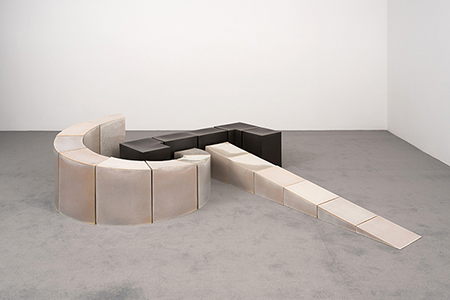
Continuing through September 16, 2023
Japanese ceramicist Kiyomizu Masahiro, born in 1954, followed a longstanding family tradition when, in 2000, he changed his name to Kiyomizu Rokubey VIII. It was then that he became the eighth-generation member of the Rokubey family to oversee production of the functional ceramic products that have been integral to life in Kyoto since the business’s founding in 1771. Prior to taking on that role, Kiyomizu was already an acclaimed sculptor working in clay, having begun his career in 1983 as the Grand Prize winner in the Asahi Ceramic Art Exhibition.
Although he currently supervises a staff of skilled artisans who create traditional utilitarian objects such as teacups and incense burners for commercial distribution, this 30-year survey focuses on Kiyomizu’s artistic practice, which operates concurrently with the business. His personal work is characterized by a consistent vision that reflects his early training in architecture and a contemporary sensibility that in many instances runs parallel to Western art of the past several decades.
Kiyomizu’s “SPACE RECEPTOR 93-A” (1993), for example, is a sleek, modular geometric clay construction that readily evokes comparison with Robert Morris’s industrially fabricated sculptures from the Jewish Museum’s 1966 landmark exhibition “Primary Structures.” In both artists’ works, elemental 3D geometric forms sprawl across the floor and interact with one another through deliberate positioning. That is where the similarities end. Morris’s signature L-beam sculptures are monolithic and realized according to the Minimalist principle that the art be exclusively self-referential, free from expressive or metaphoric considerations. By contrast, Kiyomizu prefers a simplicity that is quietly energized through contrasts among and within the parts that comprise the whole. Each of the three sections of his sculpture is a conglomerate of smaller units, while the overall composition employs three different shapes, two colors (chocolate brown and beige), and two surface qualities (matte and pearlescent).
“LINK 96” (1996) also has aesthetic ties to recent American art, in this case, to Donald Lipski’s circular, modular found-object assemblages of the 1980s-90s, where rotational movement is achieved through repetition of similar or identical units. From a distance, Kiyomizu’s sculpture looks as if it might be constructed from metal containers with cut-outs at the corners that expose the rust-colored interiors of each. Misidentification of the clay material is further encouraged by the slight concavity of the frontal exterior, which causes a lyrical interplay of light and shadow when illuminated. Such delightful deception is actually Kiyomizu’s forte, a feat that he achieves through his mastery of the tatara-zukuri or “slab-building” technique. Relying upon his architectural background, he begins a sculpture with an idea developed at his drafting table and makes cardboard templates for each section. These are then placed over clay flattened with a roller, so that a specific shape can be extracted from a clay slab using a razor blade. To join the individual slabs together to form 3D structures, Kiyomizu employs wet clay as an adhesive. All the while, he exploits the malleability of the clay by cutting slits into it, so that subtle surface effects such as sagging or curving will occur due to the pull of gravity during firing. Once sanded and glazed with an airbrush, an object is left to dry and then heated in a kiln for several hours.
Other works in the exhibition also reveal notable relationships between Kiyomizu’s sculptures and works by well known American artists. Martin Puryear comes to mind when viewing two conical floor sculptures from the “SPROUT” series (2003), while the ghosts of both Donald Judd and Robert Morris hover over “Transformation of Cube” (n.d.) and “CERAMIC CIRCLE-2023” (2023). The former is composed of four cubes with corners severed so that the cut sections appear to have split off and shifted slightly, forming an irregular shape in the center of the work that plays off against the uniformity of its overall cubic structure. In the latter piece, slats in the top of a circular structure create a rhythmic rotational movement, animating the otherwise stable work.
The exhibition is rounded out by a number of small table sculptures that employ Kiyomizu’s recurring vocabulary of shapes — cubes, pyramids, and trapezoidal prisms — all of which are punctuated with cut-outs that allow us to enjoy their interiors and exteriors simultaneously, including when viewed from above. Also on view are a few tiny utilitarian objects — incense burners and boxes — that are fashioned in his personal style, as distinct from traditional formats. In works such as these, Kiyomizu fulfills his stated goal of adding a creative element to the things we inherit from the past.
